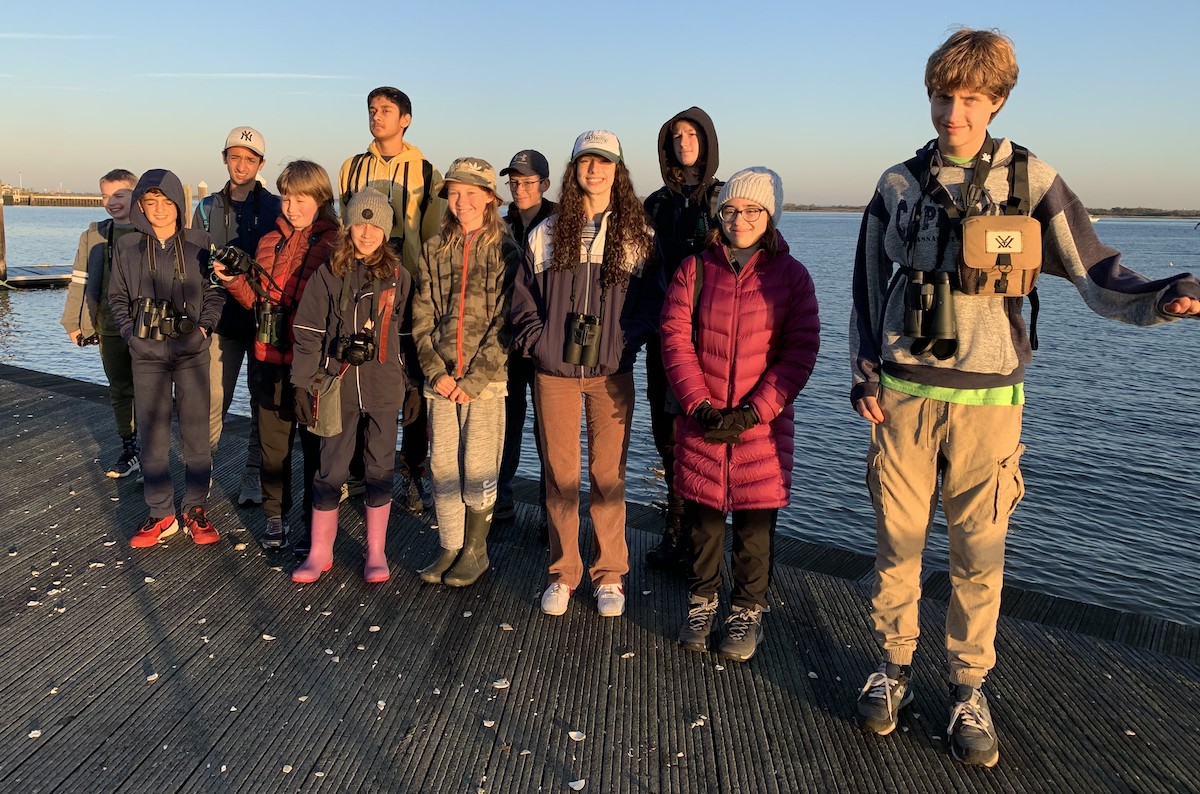Registrar: Susan Joseph
Report by: Arabella Pajoohi, age 11
Participants: 25
Weather: Started with a light autumnal chill and developed into a warm, sunny day with clear skies. Light NW winds overnight produced some movement of migrants, contributing to good diversity on the ground
Bird Species: 70
Under a dark blue sky and shining moon of an early October morning, we gathered near the sands of Jones Beach to introduce ourselves and meet our guide for this trip, Tim Healy, a local Queens resident, high school Living Environment teacher and a former NYS Young Birder’s Club member. Twenty miles from New York City, Jones Beach (located on Long Island) feels a world away with its abundance of native plants, wildlife, sandy beaches, and open ocean.
Jones Beach was molded by glaciers encroaching and relapsing during the last ice age (over 10,000 years ago) and now sits on barrier islands. In the mid-1920s, 40 million cubic yards of sand were taken from the ocean floor to raise the land and millions of seagrass plants were hand planted by thousands of men to make sure the newly excavated sand did not erode. After a causeway, parking lots, and dining and catering facilities were completed, Jones Beach opened to the public on August 4, 1929. It is now one of the most visited beaches in the world by humans and yet, as we observed, nature, despite humans, still finds a way here.
As we began taking in our spectacular surroundings on this warm October day, we spotted Yellow-rumped Warblers in the pines next to the parking lot and a flock of feeding House Finches. Then, an Indigo Bunting called as it flew overhead, and we noticed a Northern Cardinal hopping about. Suddenly, a Field Sparrow flitted out of the brush offering us a brief glimpse before retreating to its hiding spot.
We then headed down to the dock, where we spotted Double-crested Cormorants coming in for a near shore landing and preening, as well as both Ring-billed and Great Black-backed gulls. Multiple Canada geese were floating in the water while Laughing and Herring Gulls soared up above or walked and paced around on the land. A Great Blue Heron walked through the water while on a large sandbar close to shore, and we saw approximately twenty American Oystercatchers feeding in the shallows and strolling along the sand. Amongst the various gulls, a Snowy Egret strode through the water, serenely. Greater Yellowlegs walked along the sandbar with the oystercatchers as a group of Green-winged Teal flew overhead. We then witnessed a Great Black-backed Gull pecking at an unfortunate crab, another gliding in the air, and yet another riding the waves. This was our lucky day!
So far out that they were barely visible, we caught sight of a flock of Black Skimmer resting on a sandbar. And, further off in the distance, too far for our strained eyes so that we pulled out our scopes, cameras, and binoculars to view, we watched a female Black Scoter bobbing up and down like a little brown buoy in the waves, then diving and resurfacing repeatedly. By that time, nearly thirty more American Oystercatchers had sailed in to join the first ones.
We decided to move on and inspect the brush adjacent to the Coast Guard Station in hopes of spotting kinglets and warblers. We were not disappointed! Almost immediately, we heard the calls of Ruby crowned Kinglets and Yellow-rumped Warblers. A beautiful but secretive Blue-headed Vireo was both calling and hiding in the brush; luckily for us, however, it appeared from behind a clump of leaves, and we snapped photos of its head peeking out and over the clump. Northern Cardinals were also partaking in the feeding frenzy among the kinglets as Purple Finches and Cedar Waxwings flew over. Then, a female Black-and-white Warbler appeared hanging from a log propped on another tree, and just as we began to move on, a massive Northern Flicker arrived and perched atop a pine. Looking up, we noticed Eastern Meadowlarks on the move above us. While some members moved on to search again for the Blue-headed Vireo, those who stayed behind were treated to a gorgeous yet tiny Ruby-crowned Kinglet perching out in the open in a patch of sun.
As the group reconvened on the other side of the brush, a Cooper’s Hawk flew in front of us and landed on a nearby fence. Tim speculated that the Cooper’s was waiting for us to flush birds out of trees, grass, and bushes and explained that this happened with birds of prey that were used to being around humans. After perching in front of us for some time, it then flew so close it felt like we could almost reach out and touch her!
After that exciting encounter, we journeyed to a pine forest where we encountered a Red-breasted Nuthatch calling in the trees as others answered it’s calls; it then emerged and landed atop a dried-out pine tree, where it feasted on a plentiful bounty of cones. In a different pine tree, we noticed movement – a Golden-crowned Kinglet hopping about searching for its next meal of insects (these little birds eat three times their body weight each day!). We moved on to where low-lying shrubs were mixed in with grasses and short, stubby trees interspersed with sand and spotted Dark-eyed Juncos dancing about, along with White-throated and Song Sparrows. Looking up, we observed Wood Ducks flying over and heard the pipit call of American Pipits.
We then returned to our cars to bird a nearby location; a quick drive brought us to the other side of Jones Beach and the open Atlantic Ocean where we heard the sharp check calls of Yellow-rumped Warblers in the grass, and with Tim’s help spotted a Merlin on a pine tree in the distance. The Merlin appeared to be eating something, although at first we could not tell who or what. Then, the Merlin raised its prey, and we spotted the golden stripe on the head of a Golden-crowned Kinglet (nature is beautiful but painful to watch sometimes).
We ventured on, noticing beautiful and vital native Seaside Goldenrod, Beach Pea, and Beach Grass – food sources for birds and mammals alike – and encountered some Fowler’s Toads and sand toads gazing comically at us in the sand. Walking toward the waves, we passed by whale bones that had been placed there and glimpsed an Osprey flying overhead with a fish in its talons. We turned away from gazing at this beautiful bird to find a Northern Harrier far off in the skyline and one patrolling the distant dunes.
Soon after reaching the open ocean, we encountered Lesser Black-backed Gulls on the shore and spotted a flock of Sanderlings quickly flying by. The waves were irresistible and some of us ran into the ocean to enjoy the salty water while others remained on the lookout for birds. After some time (and for some of us, coaxing by our parents), we turned back toward the parking lot, where we noticed a different group of birders photographing a White-crowned Sparrow in the brush. Our group began to creep closer to the lovely little bird in hopes of capturing a photo but each time a car drove by the White-crowned Sparrow and the White-throated Sparrows accompanying it would flee back into the brush.
As we continued our day, we came across more Merlins sitting on trees and Eastern Phoebes flying off low over the grasses. Cooper’s Hawks were on the hunt, and some of us heard the call of what we believed to be a White-throated Sparrow in pain! A flash of brown and white overhead turned out to be a Savannah Sparrow accompanied by Ruby-crowned Kinglets.
As the habitat changed from trees to scrub, with lichen coating the ground, we heard a Hermit Thrush’s call and spotted more Eastern Phoebes as well as Yellow-rumped Warblers and Kinglets. We also, much to our dismay, encountered sand burrs (quite painful and difficult to remove)! After removing the burrs, we got back into our cars and returned to our beginning meeting point. By this time, the tide had swallowed the sandbar and the American Oystercatchers had disappeared, but we still spotted many birds swooping and diving and grabbing a quick snack of fish on the fly. Among the swooping mass of over one hundred Forster’s Terns was a lone Common Tern. On the grass near the pier, a Ring-billed Gull inspected us as it stood in the sun and on the pier were two hundred or so Double-crested Cormorants flying in, sunbathing, resting, and preening. Farther out, near a green buoy with a Double crested Cormorant perched atop it, a male Northern Pintail decoy bobbed up and down in the waves.
Continuing down the pier, we came across a fish (potentially about to become a tern’s snack) that flew up through the cracks in the pier, shoved about by the waves. After returning it to the water and climbing over a jumble of rocks onto the beach, we found quite a sad sight indeed. A tiny male Ruby crowned Kinglet had drowned. We buried the poor creature and set up a tiny grave for him.
We decided to end our time together on a happier note, and we concluded our day with some last minute birding on the open grass. In these final moments, a Vesper Sparrow hopped about accompanied by an entourage of White-throated Sparrows. Then, a tiny blur whizzed by, and Tim commented that it was a Ruby-throated Hummingbird, slightly late for this time of year but with the warm weather not necessarily unexpected. As Rock Pigeons and Mourning Doves roosted on a gazebo and tiny Ruby-crowned Kinglets danced about our feet, seeming not to even notice us, we shared goodbyes. With a final farewell, American Pipits flew overhead sending us on our way. Despite ongoing bird sightings, it was time to part and say our goodbyes and see you soons. Until next time!
See also: Tim Healy’s eBird checklist
Species Lists
Birds:
Brant
Canada Goose
Wood Duck
Mallard
American Black Duck
Green-winged Teal
Black Scoter
Rock Pigeon (Feral Pigeon)
Mourning Dove
Ruby-throated Hummingbird
American Oystercatcher
Sanderling
Greater Yellowlegs
Laughing Gull
Ring-billed Gull
Herring Gull
Lesser Black-backed Gull
Great Black-backed Gull
Common Tern
Forster’s Tern
Black Skimmer
Double-crested Cormorant
Great Blue Heron
Great Egret
Snowy Egret
Osprey
Northern Harrier
Sharp-shinned Hawk
Cooper’s Hawk
Belted Kingfisher
Red-bellied Woodpecker
Downy Woodpecker
Northern Flicker
Merlin
Eastern Phoebe
Blue-headed Vireo
Common Raven
Horned Lark
Ruby-crowned Kinglet
Golden-crowned Kinglet
Red-breasted Nuthatch
Brown Creeper
Winter Wren
European Starling
Gray Catbird
Northern Mockingbird
Hermit Thrush
Cedar Waxwing
House Sparrow
American Pipit
House Finch
Purple Finch
American Goldfinch
Chipping Sparrow
Field Sparrow
Dark-eyed Junco
White-crowned Sparrow
White-throated Sparrow
Vesper Sparrow
Savannah Sparrow
Song Sparrow
Swamp Sparrow
Eastern Towhee
Eastern Meadowlark
Common Grackle
Black-and-white Warbler
Yellow-rumped Warbler (Myrtle)
Northern Cardinal
Indigo Bunting
Amphibians:
Fowler’s Toad



